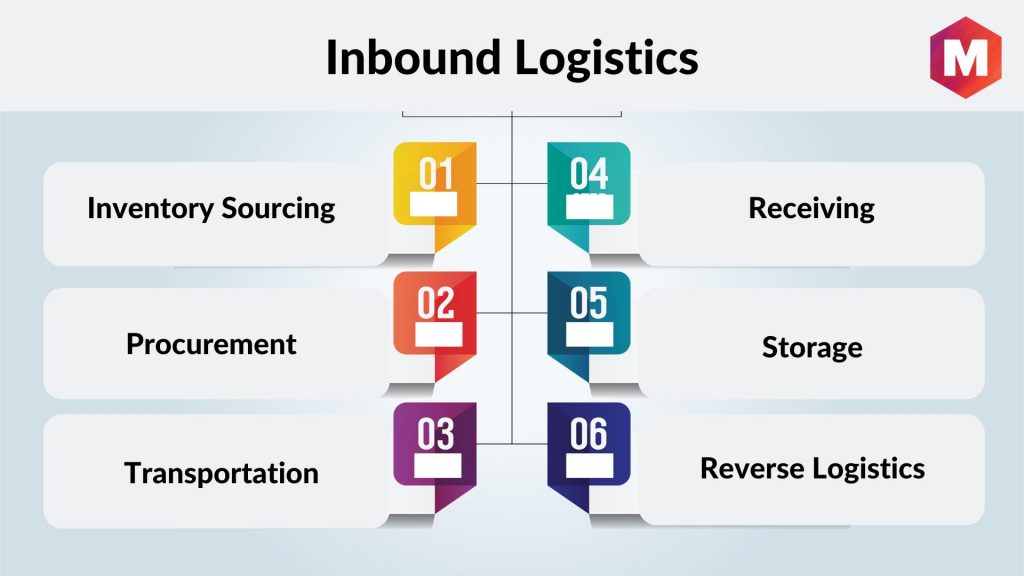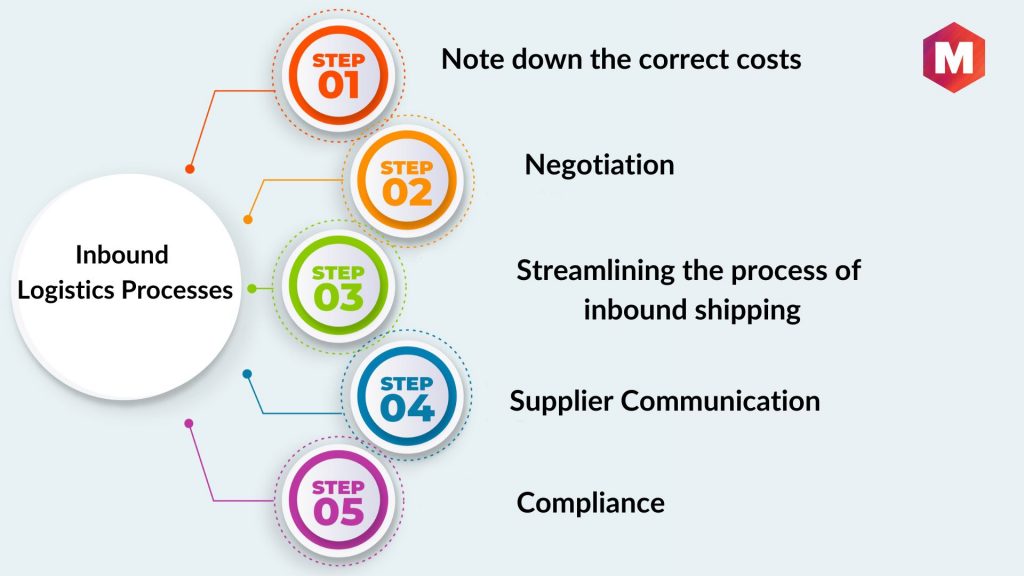Inbound logistics focuses on the processes in the supply chain that bring materials into a business or organization. This includes tasks such as managing suppliers, transportation, the inbound flow of materials in a warehouse, and related activities. In comparison, outbound logistics operations include the tasks that are necessary to move the final product out of a business in order to reach the customer. This could include tasks such as managing inventory, packaging and shipping, and quality assurance.
Both inbound logistics operations and outbound logistics processes are essential components in a company’s supply chain management strategy. To be successful in managing inbound logistics and outbound logistics, businesses should consider investing in a warehouse management system. This type of system can help in managing inbound raw materials in the warehouse, as well as in tracking and controlling outbound shipments. By automating these processes with a reliable system, businesses can ensure that inbound and outbound logistics operations run efficiently and effectively.
Table of Contents
Inbound Logistics Definition
Inbound logistics is defined as the process of transportation of goods, storage, and dissemination. On the other hand, the goods that are being exported are referred to as outbound logistics. Inbound logistics is concerned with the safe handling storage and delivery of the goods to the desired location. Inbound logistics has a great impact on the supply chain, which affects the success of the organization.
It is very crucial about the ability, and the financial burden of the transportation contract as the product moves between the buyer and the seller. It is also very crucial to keep in mind the possible damage of which vehicle to the product and it should already be clarified between the buyer and the seller as to who will be taking responsibility for the damage.
It is essential that there are a common shipping agreement and terms and conditions mentioned before proceeding with the dispatch of the goods. This understanding is between the buyer and the seller. The Terms and conditions of the shipping should be well established between the buyer and seller so that this avoids further confusion. This helps in streamlining the process of Inbound logistics and this, in turn, improves customer experience.
Importance of Inbound Logistics Process
Inbound logistics is a process that can sometimes be handled by the company itself or is outsourced to two specialized logistics companies.
This depends entirely on the nature of the goods, the financial condition of the company, the nature of the buyer and seller, the amount of transportation required for the goods to move from one place to another, and other such factors which may directly affect the goods.
For example, a new company that does not have a warehouse may prefer to use the services of a logistics company, and also an established company that has a huge turnover of goods is also preferred to outsource the logistics to a different company.
What Does Inbound Logistics Include?
Inventory Sourcing
In inbound logistics, inventory sourcing involves obtaining the raw materials needed in production by researching reliable sources. This process involves assessing a vendor’s quality, delivery capabilities, and cost in order to determine the best supplier for the company’s needs.
Procurement
Once the most reliable source is determined, it includes procurement. Procurement is the process of actually acquiring goods and services in order to meet production needs. This step involves making sure that quality contracts are in place with vendors in order to ensure delivery at a predetermined cost.
Transportation
The next step in it is transportation. In this process, the materials are delivered from the vendor’s facility (or distribution center if one is used) to the company’s warehouse or manufacturing plant. The mode of transportation will depend on the type of material being shipped as well as its urgency and cost considerations.
Receiving
The most important part of inbound logistics is the receiving process. During this phase, the goods in transit must be inspected for quality, quantity, and correctness in order to ensure that there are no discrepancies in the delivery. This is essential in maintaining customer satisfaction as it prevents complaints about late or incorrect deliveries.
Storage
Once a shipment has been received in accordance with company standards and policies, it is then stored in an inventory management system pending production or sale. The storage should be in such a way that items can quickly and easily be located when needed in order to meet customer demand.
Reverse Logistics
Finally, it also includes reverse logistics which involves returning materials back to their original source if they are defective or surplus to requirements. This is an important step in ensuring that inbound logistics flow in a logical manner and helps to control inventory costs, shipping costs, and other associated logistics costs.
Inbound logistics phases
- Supply flow management: This inbound logistics phase involves the in-depth analysis of suppliers in order to source the best materials and products for your business. It also involves an examination of inbound transportation services, in order to secure reliable delivery of goods in a timely manner.
- Procurement of stock: The procurement process is one that requires close coordination between buyers, sellers, and transport providers in order to ensure the successful purchase and delivery of supplies on time. This process should be managed carefully in order to avoid any delays in production due to unavailable or damaged materials.
- Transportation planning: Planning for transportation must be made well in advance so that all involved parties are aware of expected arrival times, type of service required as well as potential risks along the way. Risk assessments should be conducted in order to mitigate any issues that may arise in transport.
- Unloading and receipt of material: This inbound logistics phase involves the safe and efficient unloading of supplies from transportation services, in line with all safety regulations. It also requires inventory tracking in order to ensure all materials have been received and checked in correctly, as well as accurate documentation for products being stored in warehouses.
- Choice of unit load: Choosing the right type of unit load is essential in transporting goods safely and efficiently. The choice depends on the volume and dimension of the cargo, as well as its fragility or danger in transit. Careful consideration must be given to each shipment in order to determine which type of unit load will best suit its needs.
- Product labeling and consolidation: Labeling and consolidating products in inbound logistics helps streamline warehousing operations, as well as ensures that products can be identified quickly in the event of an emergency. It also allows the warehouse to keep track of inventory levels in an efficient manner.
- Storage in the ideal system: In order to ensure successful inbound logistics, it is vital that storage systems are optimized in a way that suits the needs of your business. This includes considering what type of racking or shelving solutions should be used, as well as any safety measures put in place for workers in warehouses. Having an efficient storage system in place can help reduce production costs and increase productivity in the long run.
How to optimize inbound logistics processes?
Improving inbound steps has gained importance in recent times since the companies have understood that the product should remain intact if it is delivered to the customer.
Following are a few of the steps which can be commonly carried out to improve these logistics; however, the methods vary depending on the nature of the product or service.
#1. Note down the correct costs
Every shipment will have a certain transportation cost. This cost is to be bundled with the retail price of the product.
#2. Negotiation
Nude, it is seen that the longer the contract is between the buyer and the seller, the higher the discount that is passed on. The may be other surcharges that are not mentioned in the contract, and it is essential that those costs are considered while negotiating.
For example, fuel costs. If these kinds of surcharges are not considered, then whatever cost is saved in negotiation, will be spent on this.
#3. Streamlining the process of inbound shipping
The shipping process is a long and exhausting process that involves multiple steps, right from collecting the order from the manufacturing unit and then packaging it properly, and then sending it to the seller or sometimes directly to the end customer.
Once the process is streamlined, and the process is set, the costs associated with its step can be negotiated or reduced.
#4. Supplier communication
Once the process is established and set, then it is essential that communication with the supplier is carried out. The buyer is expected to communicate this to the suppliers in writing and request the receipt of the same for confirmation.
#5. Compliance
During the entire process of shipping and inbound logistics, it is essential that compliance is maintained with the products. The accounting cost and associated costs if any are accounted for properly and are to be ensured that there is no discrepancy in them.
Making the process more compliant with improved outcomes in terms of quality.
Here is a video by Marketing91 on Inbound logistics.
Differences between Inbound and outbound logistics
- Raw material or semi-finished goods vs. finished product: In inbound logistics, the main focus is on the receipt of raw material or semi-finished goods which are then used in production. In outbound logistics, the main concern is with shipping out finished products to customers.
- Purchase vs. sale: In inbound logistics, procurement activities involve purchasing raw materials and other inputs to be used in production. Whereas in the outbound logistics process, sales activities involve selling finished goods and services to customers.
- Receiving vs. shipping: In inbound logistics, the main concern is in receiving the raw material or semi-finished goods in an efficient manner while in outbound logistics, the main focus is on shipping out finished products in a timely and cost-effective manner.
Examples of Efficient Inbound Logistics
Inbound logistics in business includes the transport and storage of incoming goods from suppliers. This can include managing the in-transit stock, tracking inbound shipments, receiving inbound items, coordinating any packing or labeling that needs to be done for distribution, and handling returns or other customer service requirements. In such logistics, it is important to develop efficient systems to ensure delivery in a timely and cost-effective manner.
Some of the most common examples of efficient inbound logistics include:
- Automating inbound processes
- Taking advantage of freight consolidation
- Using in-transit stock tracking software
- Utilizing 3PLs for inbound logistics services
- Outsourcing inbound warehouse management
- Integrating inbound processes with existing systems
- Optimizing inbound freight to reduce cost, etc
Digitization of the inbound logistics process
More and more companies in the 21st century are recognizing the importance of inbound logistics in streamlining their operations. Digitization of these logistics, in particular, has become an increasingly popular practice in recent years, as it enables businesses to automate and manage their logistics in a cost-effective manner.
By digitizing it, companies can take advantage of data-driven insights to better understand inbound supply chain operations and improve inbound performance. Additionally, advanced analytics capabilities can be used to predict inbound supply chain disruptions and in turn, reduce the risk of inefficiencies in inbound logistics.
Conclusion!
In the end, it is clear that inbound and outbound logistics are essential in the supply chain process. Inbound logistics involve sourcing, procuring, and managing raw materials in order to produce goods in a timely manner.
Outbound logistics focuses on the delivery of goods in a cost-effective and efficient way, as well as providing customer service in relation to delivery. When inbound and outbound logistics are managed in an effective way, it can have a positive impact on the overall logistics network and transportation operations in a business.
Therefore, in order to ensure the success of any supply chain process, inbound and outbound logistics should be given priority.
Liked this post? Check out the complete series on Distribution

